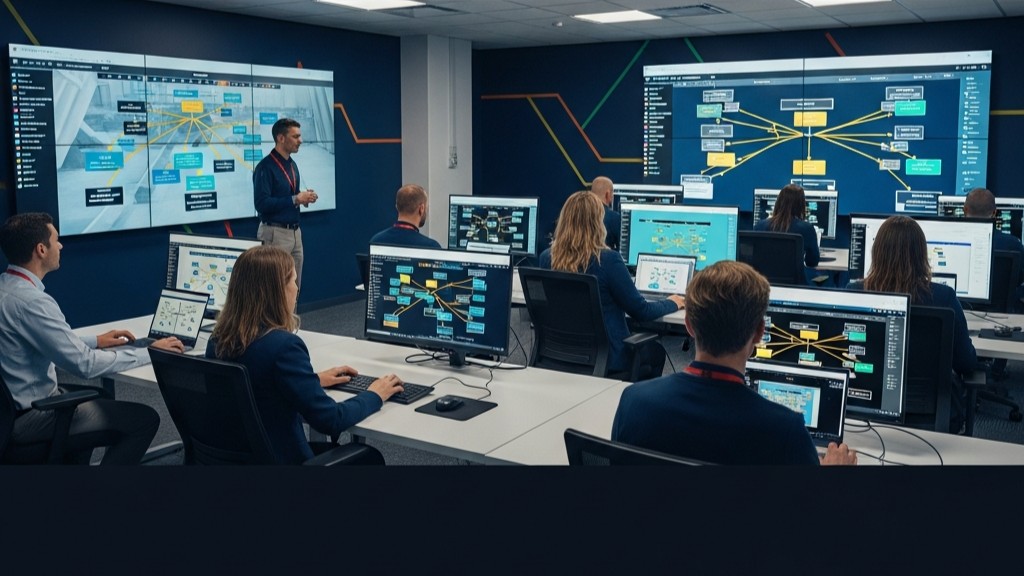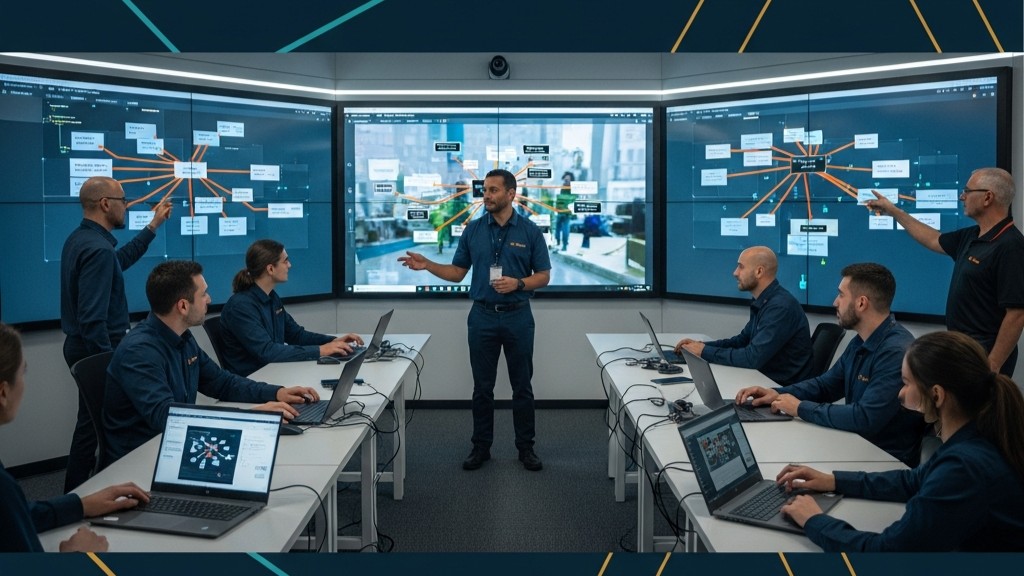What is a tabletop exercise: Benefits and key steps

A tabletop exercise (TTX) is a discussion-based simulation that guides stakeholders through a realistic scenario. Its purpose is to strengthen preparedness, coordination, and decision-making in a risk-free, informal setting.
The scope of tabletop exercises is broad, spanning preparation for natural disasters to routine network outages. Both public and private entities recognize running these exercises as best practice to support preparedness for both critical and non-critical incidents.
Read on as we cover what tabletop exercises involve, their key benefits, and how you can conduct one step-by-step.
What does a tabletop exercise involve?
Tabletop exercises are more casual than full-scale emergency simulation exercises. They are where participants meet (either virtually or in person) to discuss their responses to a simulated emergency scenario, step-by-step, as it unfolds over time.
Here is what is expected of participants and facilitators:
Participants: Engage fully, question assumptions respectfully, and collaborate on solutions within the scenario’s boundaries—even when answers are uncertain.
Facilitators: Steer the discussion, maintain pace, and prompt critical thinking without supplying the solutions themselves.
To enhance their preparedness for real-world scenarios, organizations often use software to build and deliver tabletop exercises. These tools let facilitators tailor core exercise parameters, scenario content, and evaluation criteria to their objectives. For critical and noncritical scenarios, these tools offer a flexible, interactive way to test and evaluate responses.
Key benefits of tabletop exercises
Tabletop exercises let organizations:
Validate response plan effectiveness: Exercises reveal gaps and strengths in your response plan. They simulate real-world pressures, allowing teams to refine tactics before a crisis hits.
Ensure compliance: Regular tabletop exercises demonstrate your adherence to industry standards and regulations. They create documented proof of crisis preparedness for auditors and stakeholders.
Scale preparedness: TTX software lets your organization run exercises across teams, departments, or locations from a library of scenarios tailored to your organization’s challenges.
3 types of tabletop exercise scenarios
Organizations use tabletop exercises to walk teams through a wide range of scenarios, from cyberattacks and natural disasters to public health emergencies. With TTX software, you can customize simulations to match your organization’s specific risks, roles, and compliance mandates.
Let’s consider how examples of three types of tabletop exercises look in practice.
Cyberattacks: Cybersecurity tabletop exercises let key stakeholders walk through detection, containment, and recovery processes in a risk-free environment. They also test how multiple agencies or internal stakeholders communicate and coordinate under pressure.
Natural disasters: From earthquake to flood responses, tabletop exercises let teams (whether one team or multiple) simulate full critical incident lifecycles. This spans from immediate crisis response and resource coordination to damage assessment and recovery planning.
Public health emergencies: Tabletop exercises let teams walk through complex, consequential public health scenarios. This includes simulating outbreak spread, resource triage, and clear public messaging.
How to conduct a tabletop exercise: Step-by-step guide
Here is an overview of how to conduct a tabletop exercise. If you have further questions, reach out to an Avalias team member.
Define your exercise objectives and outcomes
Begin with clarity. Identify the business function, threat, or regulation you aim to validate. Convert that focus into a small handful of measurable goals and objectives, ideally three to five. Too many goals dilute focus and cloud your metrics.
Tie each objective to a single owner, which for smaller exercises may be the same person. It’s this owner’s role to track progress during the exercise and help drive corrective actions afterward. The clearer your exercise objectives and their success criteria, the better. This clarity lets you determine which outcomes actually matter, which are just noise, and where to focus improvement efforts.
Select a relevant scenario
Choose a scenario that closely mirrors the risks your organization faces. The procedure must be realistic, engaging, and tailored to test the specific objectives you’ve set.
As a general rule, avoid generic templates. Instead, tailor injects to mirror actual vulnerabilities and operational realities. With solutions like Avalanche TTX, you can schedule customized injects for pre-determined or ad-hoc delivery and automatically log every response for precise after-action analysis. This precision forces teams to confront genuine areas for improvement, not theoretical ones.
Choose participants and roles
Select participants who reflect the roles and responsibilities being tested. Include key decision-makers for strategic scenarios; operational and technical experts for response-focused exercises; and cross-functional representatives to evaluate coordination across departments. Observers and evaluators should be present to capture insights and assess performance. If participant numbers are large, consider dividing them into relevant teams to maintain engagement and realism.
Before the tabletop exercise starts, brief every participant on the exercise’s aim, objectives and scope, including their decision-making authority. However, expect their clarity on these factors to increase as the scenario unfolds.
Set the scene and run the discussion
It’s the facilitator's role to first frame the exercise with a vivid narrative, defining time, place, and stakes. From there, they keep the conversation focused but flexible. With the help of TTX software, they guide teams through each inject, revealing elements of the scenario story as they would be experienced in real life. As events unfold, the facilitator ensures that everyone who needs to contribute to the conversation does.
The goal of the exercise isn't consensus; it's exposing how your organization actually responds under pressure. That’s why facilitators steer the conversation, not dominate it.
Capture observations
Designate note-takers or use TTX software, like Avalanche TTX, to log key observations in real time. This includes:
Key decisions and their rationale.
Information flow speed and completeness.
Resource requests, availability, and bottlenecks.
Communication channel effectiveness and failures.
Policy deviations and their immediate impact.
All observations should point toward whether or not teams are achieving the exercise objectives. Following the tabletop exercise, you should know (with clarity) what worked well, where gaps remain, and who owns each corrective action.
Complete after-action report
Compile exercise data into a structured report within 24-48 hours. You can do this by hand or have TTX software do it for you. For example, Avalanche TTX automatically captures every exercise event and following evaluation creates an export-ready after-action report with one click.
Use this data to refine response plans before the next exercise and contribute to your organization’s continuous improvement cycle.
Next-generation tabletop exercises, made easy
With Avalanche TTX, you can ensure your teams are equipped for the unexpected.
Avalanche TTX far surpasses the capabilities of traditional tabletop exercises, both paper-based and those run using standard presentation software. Its intuitive all-in-one platform enables teams to design, deliver, and review realistic simulations. It lets you create exercises that actually reflect the real world.
Ensure your team’s preparedness. Learn more about Avalanche TTX.


